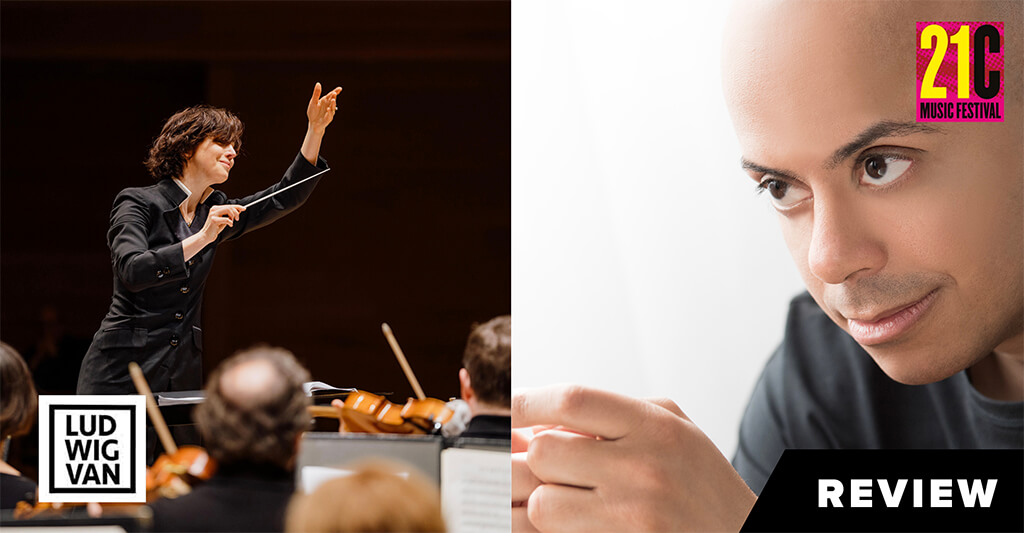
21C Ensemble of the Glenn Gould School, Toronto Symphony Orchestra, Stewart Goodyear (pianist) Tania Miller, Simon Rivard (conductors) at Koerner Hall. Wednesday.
The Royal Conservatory opened is annual 21C Music Festival on Wednesday at Koerner Hall with the formidable assistance of the Toronto Symphony Orchestra. Even at mixed strength — the ensemble included 14 players from the Glenn Gould School — the downtowners made a positive case for some Canadian works of recent vintage, notably a firecracker of a piano concerto that has repertoire potential.
This is “Ur-” by Stewart Goodyear, whom readers will recognize as a pianist of multiple achievements, including the feat of playing the 32 Beethoven Sonatas in one day. Apparently, such undertakings stimulate an interest in composition. “Ur-” is a clever, playful and pointed work of original textures and lucid form.
Advance billing implied a difficult outing for the soloist. The piece is not easy, but Goodyear applied virtuoso technique with a light touch. Repeated notes (à la Balakirev’s Islamey) seemed to poke gentle fun at the melodies they outlined. We heard strummed piano strings and muted notes from the soloist, all nicely integrated into the fabric.
There were striking effects in the orchestra, including string harmonics and a solo trumpet that floated heavenward beyond the natural range of the instrument. Normally I blanch at the sight of a drum set, but it was put to classical use in the boisterous finale. The lean harmonic language seemed perfectly attuned to the witty character of the piece.
It goes without saying that Goodyear’s performance was authoritative. Interesting, however, that he read from the music. His comments from the stage suggested that he was asked by the RCM for a work of 12 minutes (I clocked it at 13 minutes). This is not an ideal length for symphonic programming purposes. We rarely hear Prokofiev’s Piano Concerto No. 1 because it is just too short. Still, I predict a future for “Ur-”, even if we must take on faith Goodyear’s explanation of the oddball title as something derived from the botanical research of Goethe and the reductive style of Webern’s Symphony Op. 21.
If not impeccable, the accompaniment was nimble under the exacting baton of Tania Miller. Conductor and orchestra summoned a warm, penetrating tone in Jocelyn Morlock’s Nostalgia, a 14-minute lament for strings that genuinely evoked the emotion of the title. Lyric impulse was mixed with inevitable forward motion. Such is life.
Two works in the first half had their origin as movements in True North: Symphonic Ballet, a mammoth score commissioned from six composers in 2017 by the Calgary Philharmonic. It is tempting to class Northern Star by Dorothy Chang and First Winter by Dinuk Wijeratne as twin fully-orchestrated exponents of the environmental school of Canadian composition, even if the former was more effervescent and the latter (with growls in the lower brass) more shadowy. Another attempted evocation of Canadian spaces was They do not shimmer like the dry grasses on the hills, or the leaves on the trees by Emilie LeBel. No, they do not shimmer: the clusters were the densest of the evening. TSO resident conductor Simon Rivard led this with a sure ear for detail.
The program opened with a 20th-century ringer: Half-Wolf Dances Mad in Moonlight, a nine-minute piece for string quartet written in 1985 by the American Ur-minimalist Terry Riley, who is the guest star of the festival. We heard the string orchestra version. Order and rhythm were paramount. Melody, harmony and counterpoint were subsidiary concerns. The effect was of a neoclassical score with the pungent accidentals removed.
Riley said a few words, as did other composers, and Miller. A little commentary does not hurt, but I think we can do without time-consuming expressions of thanks and pro-forma testimonials to fellow artists. People who are asked to applaud repeatedly are apt to be restrained when applause is really required. Only the Goodyear generated significant enthusiasm.
It should be footnoted that the balance of the TSO was in Roy Thomson Hall playing Mozart. Koerner Hall activities continue Thursday night with a solo show by Goodyear. On Friday there is a tribute to Riley.
+++
Read more about the 21C Music Festival with Terry Riley and So Percussion.
- SCRUTINY | Moussa Concerto Sounds Strong In Toronto Symphony Orchestra Premiere, Paired With Playful Don Quixote - April 4, 2024
- SCRUTINY | Esprit Orchestra At Koerner Hall: Ligeti 2, Richter No Score - April 1, 2024
- SCRUTINY | Sibelius & New Cello Concerto By Detlev Glanert Offers A Mixed Bag From The TSO - March 28, 2024



